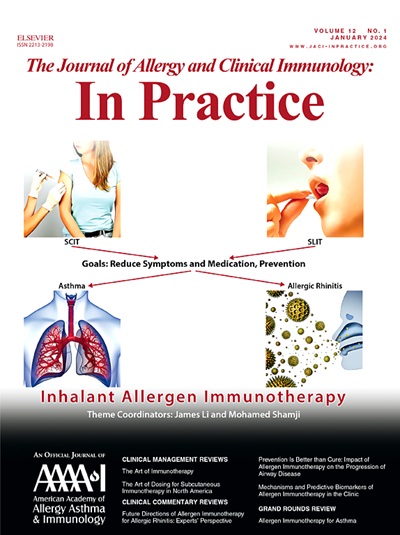儿科过敏门诊中葵花籽过敏的特征和发病率。
IF 8.2
1区 医学
Q1 ALLERGY
Journal of Allergy and Clinical Immunology-In Practice
Pub Date : 2024-11-01
DOI:10.1016/j.jaip.2024.07.029
引用次数: 0
摘要
背景:葵花籽是一种广受欢迎的不含过敏原的花生替代品:葵花籽是一种广受欢迎的不含过敏原的花生替代品:描述葵花籽过敏的发病率和特征:我们对一家儿科过敏诊所 1995 年至 2021 年期间的葵花籽过敏患者进行了一项回顾性队列研究。我们描述了葵花籽过敏患者的人口统计学特征、检测结果、特应性合并症和反应史,并计算了过敏的年累计发病率。我们使用逻辑回归法估算了 1995 年至 2021 年间每年确诊葵花籽过敏几率的增长情况:从 1995 年到 2021 年,我们共发现 235 名葵花籽过敏患者。在葵花籽过敏患者中,确诊年龄的中位数为 3.9 岁。超过四分之三的患者患有其他特应性疾病。半数反应为轻度荨麻疹或皮疹,四分之一符合过敏性休克的标准。累计发病率从 0%(1995-1999 年、2001-2004 年和 2006 年)到 0.38%(2021 年)不等。从 1995 年到 2021 年,诊断出葵花籽过敏的几率每年增加 21%(OR 1.21,95% CI:1.17-1.25):在我们的单中心葵花籽过敏儿童队列中,大多数儿童在幼儿期就被确诊,合并特应性疾病的比例很高,对葵花籽产品的皮肤反应发生率也很高。此外,在我们的队列中,葵花籽过敏的发病率呈上升趋势。本文章由计算机程序翻译,如有差异,请以英文原文为准。
Characterization and Incidence of Sunflower Seed Allergy in a Pediatric Allergy Clinic
Background
Sunflower seeds are a popular allergen-free peanut alternative.
Objective
To describe sunflower seed allergy incidence and characteristics.
Methods
We conducted a retrospective cohort study of patients with sunflower seed allergy from 1995 to 2021 in a pediatric allergy clinic. We described demographic characteristics, testing results, atopic comorbidities, and reaction histories of patients with sunflower seed allergy and calculated the annual cumulative incidence of the allergy. Logistic regression was used to estimate the increase in odds of sunflower seed allergy diagnosis for each year from 1995 to 2021.
Results
From 1995 to 2021, we identified 235 patients with sunflower seed allergy. Among patients with sunflower seed allergy, the median age at diagnosis was 3.9 years. More than three-quarters of patients had another atopic condition. Half of the reactions consisted of mild urticaria or rash, and a quarter met criteria for anaphylaxis. The cumulative incidence ranged from 0% (1995-1999, 2001-2004, and 2006) to 0.38% (2021). From 1995 to 2021, the odds of sunflower seed allergy diagnosis increased annually by 21% (odds ratio, 1.21; 95% CI, 1.17-1.25).
Conclusions
In our single-center cohort of children with sunflower seed allergy, most children were diagnosed in early childhood, had high rates of comorbid atopic conditions, and had high rates of cutaneous reactions to sunflower seed products. Moreover, in our cohort, incidence of sunflower seed allergy increased.
求助全文
通过发布文献求助,成功后即可免费获取论文全文。
去求助
来源期刊

Journal of Allergy and Clinical Immunology-In Practice
ALLERGYIMMUNOLOGY-IMMUNOLOGY
CiteScore
11.10
自引率
9.60%
发文量
683
审稿时长
50 days
期刊介绍:
JACI: In Practice is an official publication of the American Academy of Allergy, Asthma & Immunology (AAAAI). It is a companion title to The Journal of Allergy and Clinical Immunology, and it aims to provide timely clinical papers, case reports, and management recommendations to clinical allergists and other physicians dealing with allergic and immunologic diseases in their practice. The mission of JACI: In Practice is to offer valid and impactful information that supports evidence-based clinical decisions in the diagnosis and management of asthma, allergies, immunologic conditions, and related diseases.
This journal publishes articles on various conditions treated by allergist-immunologists, including food allergy, respiratory disorders (such as asthma, rhinitis, nasal polyps, sinusitis, cough, ABPA, and hypersensitivity pneumonitis), drug allergy, insect sting allergy, anaphylaxis, dermatologic disorders (such as atopic dermatitis, contact dermatitis, urticaria, angioedema, and HAE), immunodeficiency, autoinflammatory syndromes, eosinophilic disorders, and mast cell disorders.
The focus of the journal is on providing cutting-edge clinical information that practitioners can use in their everyday practice or to acquire new knowledge and skills for the benefit of their patients. However, mechanistic or translational studies without immediate or near future clinical relevance, as well as animal studies, are not within the scope of the journal.
 求助内容:
求助内容: 应助结果提醒方式:
应助结果提醒方式:


